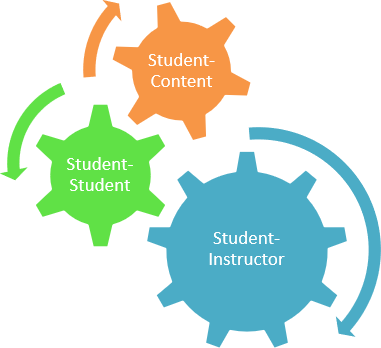
When students interact with each other, they feel like they are part of a learning community. When well-designed, this interaction can help students engage in higher-order thinking. While collaborating, students can brainstorm, deliberate, disagree, compromise, and achieve consensus—all ways of thinking that are difficult to do singly.
Consider employing some of the following strategies to encourage effective student-student interaction:
- Discussion forums in Canvas or Zoom
- Canvas Discussion Board in small groups followed up by a whole class discussion on Zoom (Video: Using Discussion Boards – Faculty Panel).
- Think-pair-share through Zoom breakout rooms (April Cordero).
- Prepare and give multimedia presentations. These can be given in small groups with Q&As from classmates; or could be put into Canvas for students to view and give feedback; or could be given as a presentation to the class on Zoom. (Student Created Video)
- Peer review activities for writing assignments or multimedia projects
- Canvas peer review
- The PLNU Writing Checklist can help students give feedback to peers
- Group projects using Google Docs or Slides (concept maps, diagram a process, protocol, procedure or course of action, conference-type posters, analyze data sets and create data visualizations)
- Study groups
- Groups can even create a resource guide for future students: “How to do well in this class.”
Lecture: After a lecture, small groups of students complete a follow-up activity:
- Participate in a “think-pair-share” activity: The instructor poses a question, students write down their initial thoughts, students are distributed in small groups into breakout rooms to discuss and possibly come to a consensus. They are then pulled back together as a group to discuss and synthesize or possibly vote.
- Small groups solve problems on a worksheet based on new information in lecture. (Victor Labenske)
- Illustrate or diagram ideas from the lecture on the web conference whiteboard or Google Slide or Google Doc. or work a problem or formula…..
- Ask students to come prepared to lead a discussion in Zoom either with the whole class or in their small group on specific topics they have read and prepared in advance.
- Breakout groups read through a case study, using the content from the lecture and homework reading to make choices and decisions. All come back together for discussion or they post on a Canvas Db. (Brittany Johnson)
Student groups can arrange their own virtual meetings and choose the tools they want to collaborate on. They can use Zoom, Google Meet or other web-based tools.
Here is the Collaborative Tools video with April Cordero, Donna Marvel, Gayle Sollfrank, and Victor Labenske. Demo of Google Docs, Google Slides, and Break-out rooms.
Resources:
- Darby, F. (2019). Small Teaching Online: Applying Learning Science in Online Classes. Jossey-Bass
- Boettcher, J. V., Conrad, R. M (2016). The Online Teaching Survival Guide, 2nd ed. Jossey-Bass.
- Costa, K. (2020). 99 TIps for Creating Simple and Sustainable Educational Videos. Stylus.
- Riggs, S. (2020). Student-Centered Remote Teaching: Lessons Learned from Online Education. Transforming Higher Ed.